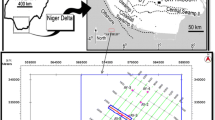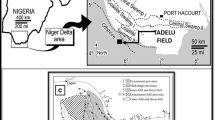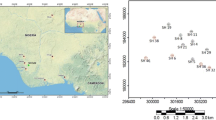Abstract
The daunting challenge in the exploration and production of oil and gas in the face of continual rise in the world’s energy consumption has long been how to economically recover bypassed reserves within existing assets. This research is focused on the analysis of prospects and volumetric estimation of the hydrocarbon reservoirs delineated within an exploratory field using 3D seismic data and suites of wireline logs. The prospectivity of the delineated reservoir was carried out using seismo-structural interpretation and formation evaluation towards the assessment of the prolific hydrocarbon occurrence within the field. The reservoirs have porosity (0.29–0.32) for H1, (0.20–0.31) for H2 and (0.30–0.40) for H3 and the average computed hydrocarbon saturation of (0.31–0.62) for H1, (0.16–0.52) for H2 and (0.64–0.73) for H3, hydrocarbon pore volume (HCPV) of 28,706.95, 33,081.2 and 45,731.49 barrels for H1, H2 and H3, respectively, while the estimated stock tank oil initially-in-place (STOIIP) range (136.8–140.73) MMSTB for H1, (36.77–489.64) MMSTB for H2 and (166.62–308.14) MMSTB for H3. The observed porosity and hydrocarbon saturation for the delineated reservoirs as well as the estimated hydrocarbon pore volume and storage total oil in place indicate that the reservoirs are highly prolific. The study has therefore contributed to the understanding of hydrocarbon resource potential within the study area.

Modified from Damuth (1994)











Similar content being viewed by others
References
Akaegbobi, I. M., Nwachukwu, J. I., & Schmitt, M. (2000). Aromatic hydrocarbon distribution and calculation of oil and gas volumes in Post-Santonian Shale and Coal, Anambra Basin, Nigeria. In M. R. Bello & B. J. Katz (Eds.), Petroleum systems of South Atlantic Margins (Vol. 73, pp. 233–245). American Association of Petroleum Geologists Memoir.
Allen, J. R. L. (1965). Late Quaternary Niger Delta and adjacent areas: Sedimentary environments and lithofacies. American Association of Petroleum Geologists Bulletin, 49, 547–600.
Anomneze, D. O., Okoro, A. U., Ajaegwu, N. E., Akpunonu, E. O., Ahaneku, C. V., Ede, T. A. D., et al. (2015). Application of seismic stratigraphy and structural analysis in the determination of petroleum plays within the eastern Niger Delta Basin, Nigeria. Journal of Petroleum Exploration and Production Technology, 5, 113–122. https://doi.org/10.1007/s13202-015-0161-2.
Archie, G. E. (1942). The electrical resistivity as an aid in determining some reservoir characteristics. Journal of Petroleum Technology, 5, 54–62.
Asquith, G. (2004). Basic well log analysis. American Association of Petroleum Geologists Methods in Exploration Series, 16, 12–135.
Avbovbo, A. A. (1978). Tertiary lithostratigraphy of Niger delta. American Association of Petroleum Geologists Memoir Bulletin, 62, 295–306.
Chapin, M., Swinburn, P., Weiden, R. V., Skaloud, D., Adesanya, S., Stevens, D., et al. (2002). Integrated seismic and subsurface characterization of Bonga field, offshore Nigeria. The Leading Edge, 21(11), 1125–1131.
Damuth, J. E. (1994). Neogene gravity tectonics and depositional processes on the deep Niger Delta continental margin. Marine and Petroleum Geology, 11, 320–346.
Deptuck, M. E., Sylvester, Z., Pirmez, C., & O’Byrne, C. (2007). Migration-aggradation history and 3-D seismic geomorphology of submarine channels in the Pleistocene Benin-major Canyon, western Niger Delta slope. In: R. B. Wynn, & B. T. Cronin (Eds.), Sinuous deep-water channels; Genesis, geometry and architecture, Marine and Petroleum Geology (Vol. 24(6–9), pp. 406–433). Elsevier.
Doust, H., & Omatsola, M. E. (1990). Niger Delta. In J. D. Edwards & P. A. Santogrossi (Eds.), Divergent/passive margin basins (Vol. 48, pp. 239–248). American Association of Petroleum Geologists Memoir Bulletin.
Ejedawe, J. E. (1981). Patterns of incidence of oil reserves in Niger Delta Basin. American Association of Petroleum Geologists Bulletin, 65, 1574–1585.
Ejedawe, J. E., Coker, S. J. L., Lambert-Aikhionbare, D. O., Alofe, K. B., & Adoh, F. O. (1984). Evolution of oil-generative window and oil and gas occurrence in Tertiary Niger Delta Basin. American Association of Petroleum Geologists Bulletin, 68, 1744–1751.
Larionov, V. V. (1969). Borehole radiometry. Moscow: S.R. Nedra.
Lawrence, S. R., Munday, S., & Bray, R. (2002). Regional geology and geophysics of the eastern Gulf of Guinea (Niger Delta to Rio Muni). The Leading Edge, 21, 1112–1117.
Nigerian Oil and Gas Sector Report. (2014). The long journey. CSL Report, 50 p.
Oyeyemi, K. D., & Aizebeokai, A. P. (2015). Hydrocarbon trapping mechanism and petrophysical analysis of Afam field, offshore Nigeria. International Journal of Physical Sciences, 10(7), 222–238.
Oyeyemi, K. D., Olowokere, M. T., & Aizebeokhai, A. P. (2017a). Hydrocarbon resource evaluation using combined petrophysical analysis and seismically derived reservoir characterization, offshore Niger Delta. Journal of Petroleum Exploration and Production Technology. https://doi.org/10.1007/s13202-017-0391-6.
Oyeyemi, K. D., Olowokere, M. T., & Aizebeokhai, A. P. (2017b). Evaluation of optimal reservoir prospectivity using acoustic-impedance model inversion: A case study of an offshore field, western Niger Delta, Nigeria. NRIAG Journal of Astronomy and geophysics, 6(2), 300–310.
Reijers, T. J. A. (2011). Stratigraphy and sedimentology of the Niger Delta. Geologos, 17(3), 133–162.
Sanuade, O. A., Akanji, A. O., Olaojo, A. A., & Oyeyemi, K. D. (2017). Seismic interpretation and petrophysical evaluation of SH field, Niger Delta. Journal of Petroleum Exploration and Production Technology. https://doi.org/10.1007/s13202-017-0363-x.
Acknowledgments
The authors wish to appreciate the efforts and valuable comments of reviewers and the editor that have improved greatly the quality of this paper. We are grateful to the Schlumberger for providing the required software package and department of petroleum resources (DPR) Nigeria for the provision of data used for this research.
Author information
Authors and Affiliations
Corresponding author
Rights and permissions
About this article
Cite this article
Oyeyemi, K.D., Olowokere, M.T. & Aizebeokhai, A.P. Prospect Analysis and Hydrocarbon Reservoir Volume Estimation in an Exploration Field, Shallow Offshore Depobelt, Western Niger Delta, Nigeria. Nat Resour Res 28, 173–185 (2019). https://doi.org/10.1007/s11053-018-9377-4
Received:
Accepted:
Published:
Issue Date:
DOI: https://doi.org/10.1007/s11053-018-9377-4




